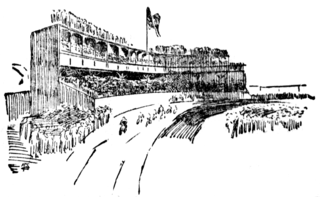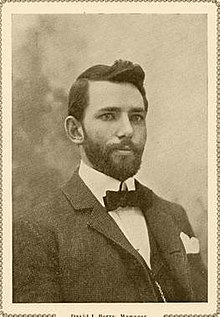
Christopher Mathewson, nicknamed "Big Six", "the Christian Gentleman", "Matty", and "the Gentleman's Hurler", was an American Major League Baseball right-handed pitcher, who played 17 seasons with the New York Giants. He stood 6 ft 1 in (1.85 m) tall and weighed 195 pounds (88 kg). He was among the most dominant pitchers in baseball history, and ranks in the all-time top 10 in several key pitching categories, including wins, shutouts, and earned run average. In 1936, Mathewson was elected into the Baseball Hall of Fame as one of its first five members.

Recreation Park was a sporting grounds and stadium that stood from 1865 to 1905 in Allegheny City, Pennsylvania, which was annexed in 1907 and became the North Side region of Pittsburgh. The park was bounded by Allegheny Avenue, Pennsylvania Avenue, Grant Avenue, and Boquet Street.

Edward James Abbaticchio was the first Major League Baseball player and first professional football player of Italian ancestry, both chronologically and alphabetically.
George Oliver Barclay was an American football and baseball player. He played Major League Baseball for the St. Louis Cardinals and later the Boston Beaneaters. He was also an early professional football player-coach for the Greensburg Athletic Association. He was nicknamed "The Rose" for his concern with his looks and "Deerfoot" because of his speed. Barclay also invented the first football helmet.
The Latrobe Athletic Association was a professional football team located in Latrobe, Pennsylvania, from 1895 until 1909. A member of the unofficial Western Pennsylvania Professional Football Circuit, the team is best known for being the first football club to play a full season while composed entirely of professional players. In 1895, team's quarterback, John Brallier, also became the first football player to openly turn professional, by accepting $10 and expenses to play for Latrobe against the Jeannette Athletic Club.
The Greensburg Athletic Association was an early organized football team, based in Greensburg, Pennsylvania, that played in the unofficial Western Pennsylvania Professional Football Circuit from 1890 until 1900. At times referred to as the Greensburg Athletic Club, the team began as an amateur football club in 1890 and was composed primarily of locals before several professional players were added for the 1895 season. In 1894 it was discovered that the team had secretly paid formerly Indiana Normal player, Lawson Fiscus, to play football and retained his services on salary. The team was the chief rival of another early professional football team, the Latrobe Athletic Association.
The Philadelphia Athletics was a professional American football team based in Philadelphia in 1902. The team was a member of what was referred to as the National Football League. This league has no connection to the National Football League of today. The whole "league" was a curious mixture of baseball and football. During the league's only year in existence, two of the three teams that were financed by the owners of the Philadelphia Athletics and the Philadelphia Phillies, hence the names Philadelphia Athletics and Philadelphia Phillies. The Pittsburgh Stars made up the third team and were suspected of being financed by the Pittsburgh Pirates baseball team.
The first National Football League (NFL) was the first attempt at forming a national professional American football league in 1902. This league has no ties with the modern National Football League. In fact the league was only composed of teams from Pennsylvania, which meant it was actually regional, despite having locations in the two largest cities in Pennsylvania. Two of the teams were based in Philadelphia, while the third was based in Pittsburgh. This NFL was a curious mixture of football players and baseball players who adapted to playing football. Future Baseball Hall of Famer Rube Waddell was with the Philadelphia Athletics, and pitcher Christy Mathewson a fullback for Pittsburgh. Two of the three teams were owned by the Philadelphia Phillies and Philadelphia Athletics, with the third team suspected of being owned by the Pittsburgh Pirates. The league folded after the 1902 season.
The Philadelphia Phillies were a professional American football team based in Philadelphia, Pennsylvania in 1902. The team was a member of what was referred to as the National Football League—not to be confused with the National Football League of today. The whole league was a curious mixture of football players as well as baseball players who adapted to playing football. The Phillies were owned and financed by baseball's Philadelphia Phillies just as the owners of the Philadelphia Athletics financed their team, the Philadelphia Athletics. The Pittsburgh Stars made up the third team and was suspected of being financed by the Pittsburgh Pirates baseball team.
The Duquesne Country and Athletic Club was a professional football team based in Pittsburgh, Pennsylvania from 1895 until 1900. The team was considered one of the best, if not the best, professional football teams in the country from 1898 until 1900. However, the team is most famous for being the first football franchise to be owned by an individual, William Chase Temple.
The World Series of Football was a series of football games played indoors at New York City's Madison Square Garden in 1902 and 1903. It originally comprised five teams, four from the state of New York and one from New Jersey. While none of the teams were really considered the best in the country, historians refer to the affair as a "World Series". However, it was hardly a series in the sense of two strong teams playing each other over several games. In fact, no team played another more than once and the team pairings were also considered odd. Under the 1902 system, the anticipated second-place team was automatically swept into the championship game without even playing a down while the expected first-place finisher had to fight its way through the brackets, effectively creating a cross between a traditional tournament and a "gauntlet-style" tournament for the first-place team.

Charles Edgar "Blondy" Wallace was an early professional football player and later convicted criminal during the Prohibition Era. He was a 240-pound, former Walter Camp second-team All-American tackle from the University of Pennsylvania. He also played two years at Peddie Institute, in New Jersey, winning state championships in 1896 and 1897. During his professional playing career he was involved in almost every major event in professional football between 1902 and 1907. Over that timespan he played for the independent Philadelphia Athletic Club, the Philadelphia Athletics of the first National Football League, the "New York" team and the Syracuse Athletic Club in the 1902 World Series of Football, the Franklin Athletic Club and the Canton Bulldogs of the Ohio League. In 2022, he was named one of the 10 inaugural members for the Football Learning Academy's Hall of Honor, which looks to acknowledge deserving icons that are not currently inducted in the Pro Football Hall of Fame.

Frederick Joseph Crolius was an American football and baseball player and coach. He was the first player from Tufts University to play Major League Baseball. He was at Tufts in 1894, and at Dartmouth College, where he also played college football, from 1896 until 1899. He spent two years in majors with the Boston Beaneaters and the Pittsburgh Pirates. Crolius also played pro football with the independent Homestead Library & Athletic Club and the Pittsburgh Stars of the first National Football League. He later served as a coach of both sports after his playing career ended.
Charles Robert Shiring was a professional football player from Pittsburgh, Pennsylvania. He began his playing career with the Pittsburgh Athletic Club during the late 1890s and the Homestead Library & Athletic Club in 1901. In 1902, he played for the Pittsburgh Stars of the first National Football League (NFL) who ended up winning the league title. Since the Stars consisted of the best professional players from western Pennsylvania at the time, it can be said that Shiring was considered the best at his position, center, in the region. However Shring is best known for playing for the Massillon Tigers from 1903 until 1907. He finally served from 1907 to 1909 as a player-coach for the Pittsburgh Lyceum, Pittsburgh's last championship professional football team, until the 1970s.
Willis Richardson was an American professional American football player-coach for the Homestead Library & Athletic Club and the Pittsburgh Stars of the first National Football League (NFL). He won the Western Pennsylvania State Championship with Homestead in 1900 and 1901. Then in 1902, he brought along many former Homestead players to the Stars team, which was formed by the former Latrobe Athletic Association manager, Dave Berry, and probably funded by the Barney Dreyfuss and William Chase Temple of the Pittsburgh Pirates baseball team. During the Stars "championship game" against the Philadelphia Athletics, Willis scored an extra point to help lead the Stars to an 11–0 victory and the 1902 championship.

David J. Berry was an American football manager during the late 19th and early 20th centuries. He was the top promoter for the sport during that time period. He is credited with inventing the "all-star game concept" in 1898, and also helped to form one of the first organized football leagues in 1902.
Harry Wilson "Cap" Ryan was an early professional football player for the Latrobe Athletic Association from 1895 until 1906. He was also selected to be the first captain in that team's history. He played alongside John Brallier who is considered the first openly professional football player. In 1897 he was named to the "All Western Pennsylvania Team" by The Pittsburg Times.
"New York" was a professional football team formed by promoter Tom O'Rouke for the World Series of Football in 1902. The event was held in New York City at Madison Square Garden. It featured five football teams from New York and New Jersey: the Syracuse Athletic Club, Orange Athletic Club, Knickerbocker Athletic Club, Warslow Athletic Club and "New York". The "New York" team was designed and heavily favored to win the tournament. However, they were defeated in the opening game by Syracuse.
The 1898 Western Pennsylvania All-Star football team was a collection of early football players, from several teams in the area, to form an all-star team. The team was formed by Dave Berry, the manager of the Latrobe Athletic Association, for the purpose of playing the Duquesne Country and Athletic Club, which fielded a team composed of many of the game's stars from the era. The game between the two clubs ended in a 16-0 Duquesne victory and is considered to be the first all-star game for professional football. Contrary to popular belief, while the game was held at Exposition Park, which would be currently located inside of the city limits of Pittsburgh, Pennsylvania, the 1898 location of the game was Allegheny, Pennsylvania which was not incorporated into the city of Pittsburgh until 1907.
Herman Charles Kerkhoff was a professional American football player from the mid 1890s until 1906.






